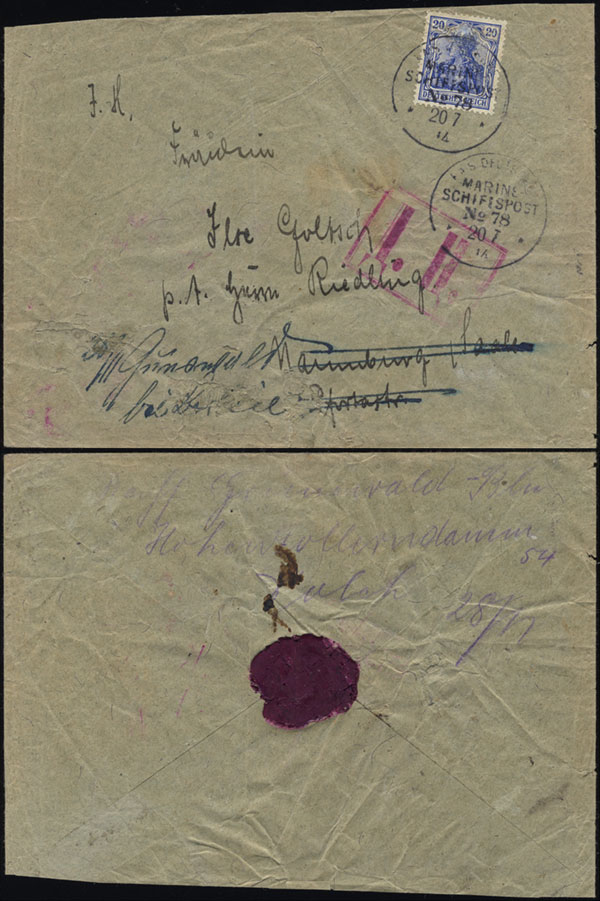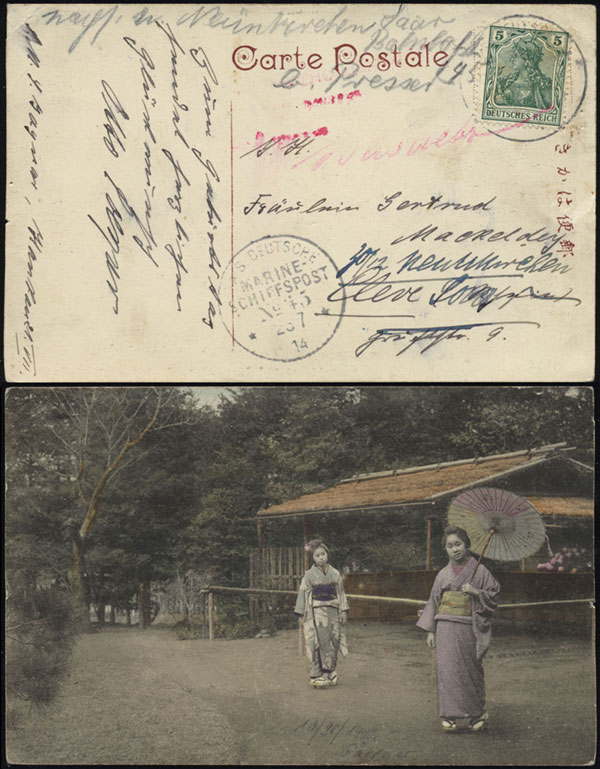Censorship of Trans-Siberian Mail - German China/Kiautschou
Aug 31, 2022 17:32:55 GMT -5
kacyds, Gordon Lee, and 4 more like this
Post by PostmasterGS on Aug 31, 2022 17:32:55 GMT -5
When Germany first established a presence in China in the 1880’s, mail from German Post Offices in China to Germany was transported almost exclusively via the sea. The various shipping lines serving the Far East were the quickest, most efficient manner of transportation.
In 1891, Russia began construction of the Trans-Siberian Railroad. As longer portions of it were completed, Germany experimented with sending mail from China back to Germany via the railroad. These trials could only be conducted during the winter because there was still a significant gap in the line at Lake Baikal, and transportation across the lake was easier when it was frozen over. After three trials in the winters of 1896-1897, 1897-1898, and 1898-1899, it was determined that the transit times were actually slower than via the existing sea routes, and this routing was temporarily abandoned.
In October 1903, Germany once again began routing mail through Russia. There were several periods of interruption (Russo-Japanese War in 1904-1905, Mongolian plague outbreak in 1911), but from 1907-1914, mail traveling this route became more popular, with transit times of approximately 2 weeks. It's common to see mail from German China / Kiautschou during this period with a “Via Siberia” route marking.
However, with the outbreak of World War I, Russia intercepted and returned to German China/Kiautschou any German mail traveling this route. The mail then had to bent sent via alternate routes, often through the US. Much of the mail was censored prior to its return from Russia, and four Russian censorship markings are known (shown here in increasing order of rarity).
The first is a framed Cyrillic “Д.Ц.” (short for Дозволено Цензурой, or Doswoleno Zensuroi — meaning it passed censorship).

The second states contains similar language (Passed Censor / Military Censor) and a signature, “Babaew”?

The third, which is only known on mail from German China (not Kiautschou), contains the same language, but is signed “Geivochu” or “Geiwotschu”

The fourth, which is only known on mail from German China (not Kiautschou), is a circle with a Cyrillic “Д.Ц.”

At the same time, however, there were German naval vessels in Chinese waters. The use of Russian censor marks on these Marine-Schiffspost items is exceptionally rare.
The framed “Д.Ц.” is known on four Marine-Schiffspost covers, three unfranked and one franked.
The second censor mark is known on two unfranked Marine-Schiffspost covers and one franked Marine-Schiffspost postcard.
I recently acquired both franked copies:

This cover was sent from the river gunboat S.M.S. Tsingtau (MSP No. 78) on 20 July 1914, on which date it was in the upper reaches of the Hsikiang river (now called the Xi River). It was addressed to Fräulein Ilse Goltsch in Naumburg, but was redirected to Grunewald, Berlin. As evidence of the return to Kiautschou and subsequent re-routing, it didn’t arrive in Naumburg until 28 November 1914.

This postcard was sent from the gunboat S.M.S. Jaguar (MSP No. 45) on 23? July 1914, on which date the Jaguar was in Shanghai — though it was written several days earlier when the gunboat was in Hankau (modern Wuhan). It was addressed to Fräulein Gertrud Mackeldey in Cleve, but was re-directed to Neunkirchen. There are no arrival or transit markings, so the address change is the only indication this item was ever sent to Germany after being returned from Russia. The text reads:
In 1891, Russia began construction of the Trans-Siberian Railroad. As longer portions of it were completed, Germany experimented with sending mail from China back to Germany via the railroad. These trials could only be conducted during the winter because there was still a significant gap in the line at Lake Baikal, and transportation across the lake was easier when it was frozen over. After three trials in the winters of 1896-1897, 1897-1898, and 1898-1899, it was determined that the transit times were actually slower than via the existing sea routes, and this routing was temporarily abandoned.
In October 1903, Germany once again began routing mail through Russia. There were several periods of interruption (Russo-Japanese War in 1904-1905, Mongolian plague outbreak in 1911), but from 1907-1914, mail traveling this route became more popular, with transit times of approximately 2 weeks. It's common to see mail from German China / Kiautschou during this period with a “Via Siberia” route marking.
However, with the outbreak of World War I, Russia intercepted and returned to German China/Kiautschou any German mail traveling this route. The mail then had to bent sent via alternate routes, often through the US. Much of the mail was censored prior to its return from Russia, and four Russian censorship markings are known (shown here in increasing order of rarity).
The first is a framed Cyrillic “Д.Ц.” (short for Дозволено Цензурой, or Doswoleno Zensuroi — meaning it passed censorship).

The second states contains similar language (Passed Censor / Military Censor) and a signature, “Babaew”?

The third, which is only known on mail from German China (not Kiautschou), contains the same language, but is signed “Geivochu” or “Geiwotschu”

The fourth, which is only known on mail from German China (not Kiautschou), is a circle with a Cyrillic “Д.Ц.”

At the same time, however, there were German naval vessels in Chinese waters. The use of Russian censor marks on these Marine-Schiffspost items is exceptionally rare.
The framed “Д.Ц.” is known on four Marine-Schiffspost covers, three unfranked and one franked.
The second censor mark is known on two unfranked Marine-Schiffspost covers and one franked Marine-Schiffspost postcard.
I recently acquired both franked copies:

This cover was sent from the river gunboat S.M.S. Tsingtau (MSP No. 78) on 20 July 1914, on which date it was in the upper reaches of the Hsikiang river (now called the Xi River). It was addressed to Fräulein Ilse Goltsch in Naumburg, but was redirected to Grunewald, Berlin. As evidence of the return to Kiautschou and subsequent re-routing, it didn’t arrive in Naumburg until 28 November 1914.

This postcard was sent from the gunboat S.M.S. Jaguar (MSP No. 45) on 23? July 1914, on which date the Jaguar was in Shanghai — though it was written several days earlier when the gunboat was in Hankau (modern Wuhan). It was addressed to Fräulein Gertrud Mackeldey in Cleve, but was re-directed to Neunkirchen. There are no arrival or transit markings, so the address change is the only indication this item was ever sent to Germany after being returned from Russia. The text reads:
Congratulations on your birthday. Otto Poerpur




